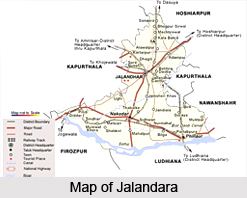 Jalandhar is an ancient city in the Punjab state of India. It is situated 375 kilometers from Delhi and 90 kms from Amritsar. Jalandhar was the capital of Punjab till 1953 after which it was replaced by Chandigarh. The name Jalandhar originated as a result that it is located between two rivers namely Jal and Andhar. During British occupation, Jalandhar was known as Jullundur. The place was the capital of Trigarttas during the times of Mahabharata war.
Jalandhar is an ancient city in the Punjab state of India. It is situated 375 kilometers from Delhi and 90 kms from Amritsar. Jalandhar was the capital of Punjab till 1953 after which it was replaced by Chandigarh. The name Jalandhar originated as a result that it is located between two rivers namely Jal and Andhar. During British occupation, Jalandhar was known as Jullundur. The place was the capital of Trigarttas during the times of Mahabharata war.
History of Jalandhar
The country takes its name from the great Daitya King Danava Jalandhara, the son of the Ganga (ocean). In history, the earliest mention of Jalandhar occurs during the reign of Kanishka, the Kushan king of Northern India. During the 7th Century, when Hiuen Tsang, the famous Chinese traveller and pilgrim visited India during the reign of Harsha Vardhana, the Kingdom of Jalandhara or Trigartta was under the rule of Raja Utito.
According to Fahien, the Chinese pilgrim, there were many Vihars of Buddhism in India. There were about 50 Vihars of Buddhism in the Jalandhar Doab. In AD 1019, the district was included in the Shahi Kingdom of Punjab and Jalandhar was an important city in the region.
 Economy of Jalandhar
Economy of Jalandhar
Jalandhar is renowned for the production of sports equipments, leather goods, rubber goods etc. In sports goods, some of the world`s most well known line for football, cricket and hockey equipments are made in Jalandhar. The place is also famous for surgical tool industry. The city claims to have the largest number of Hospitals in Asia. Jalandhar also has the biggest printing industry in India. Jalandhar is also quite known for its electrical goods industry. Jalandhar is the media and mass communication hub of the region having the regional headquarters of the national television and radio channels. Then Phagwara in Punjab is famous for cloth manufacturing and drapery shops and Kartarpur is one of the biggest exporters of quality furniture.
Places of Interest in Jalandhar
Devi Talab Mandir, Shiv Mandir, Sodal Mandir, Tulsi Mandir, Gurdwara Chhevin Pathshahi, Gurudwara Talhan Sahib, St. Mary`s Cathedral Church and Gurudwara Nauwi Patshahi are some of the religious spots in Jalandhar.
The other places of interest in this ancient city are Pushpa Gujral Science City, Fun City, Company Bagh, Niku Park, Rangla Punjab and Wonder Land.
Important Personalities from Jalandhar
The famous spin bowler of Indian cricket team Harbhajan Singh comes from Jalandhar. The other famous personalities that hail from Jalandhar are Apache Indian, Hans Raj Hans, Jasbir Jassi, Jazzy B, Salim, and Sarabjit Cheema, K.L. Saigal etc.



















